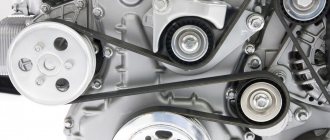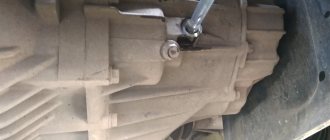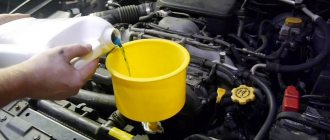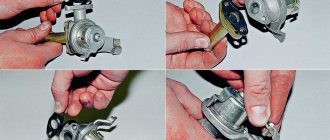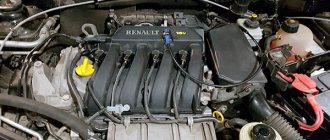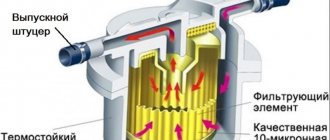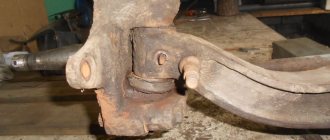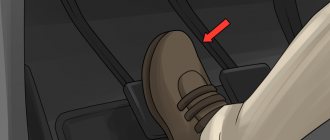Let’s say right away that we strongly do not recommend replacing tires yourself, because this process will not ensure adequate safety on the road. You can perform high-quality tire fitting in your garage only if you have a wheel balancing machine and a sufficient number of weights that will help complete this balancing process. Otherwise, you obviously won’t be able to carry out all the processes efficiently; at speed, the steering wheel will tap, and when braking, you will feel the vibration of the entire car. Therefore, changing tires with your own hands is highly not recommended.
But situations are different. Sometimes it turns out that a tire breaks down on the road, but there is no spare wheel; in the trunk you can only find a tire repair kit. Some breaks cannot be repaired without removing the wheel. Sometimes we simply do not have the opportunity to use tire fitting services. In such cases, you can use your own strength and change the tires.
The average cost of this service in Russia and what it depends on
During the onset of the winter season, every car owner asks the question: how much does it cost to change your car to winter tires? The price for tire fitting services varies depending on the size of the workshop, brand promotion, quality of equipment and service provided in working with the client. The higher these indicators, the more expensive the service will be.
Prices do not differ much across the regions of Russia: whether it is Moscow or Novorossiysk, there will be no significant difference. The final cost also depends on the type of car, wheel radius and type of rims.
The cost of tire fitting services depends on the region, type of car and tire size, as well as additional services
Complex tire changes are one of the most expensive and labor-intensive tire fitting jobs. It includes removing and installing wheels, removing tires from the rim, mounting and balancing. On average, “re-shoeing” a complete set for a passenger car will cost from 1,400 to 5,000 or more.
If additional services are provided, the amount will increase. To add. services include:
- out-of-turn service;
- low profile tires;
- alloy wheels;
- installation of a tubeless valve;
- sealing the disc rim;
- recycling of old tires.
Choosing wheels and tires: what to look for and how not to make a mistake
Car wheels and tires. At first glance, it seems that it could be simpler? But we would pose the question differently: what could be more important? Perhaps, it is the tires - these inconspicuous parts at first approach - that are the second most important in terms of safety (after brakes) and the first busiest part, which constantly works in difficult road conditions and on which the life and health of motorists depends.
That is why the car owner must make special demands on tires in particular and wheels in general and take an extremely responsible approach to their purchase/change/update or improvement.
Yes, many will say: what is the wisdom of buying tires? After all, this is one of the simplest modifications that can be made by any car owner, even those far from the technical automotive part. But in order to choose the right tire, you need to know a number of nuances, and that’s exactly what we’d like to talk about today. Here's what you need to know before you go shopping for "shoes" for your car.
How to change shoes yourself
Changing wheels at home is not an easy task, requiring appropriate skills and information. After this article, you will learn how to change summer tires to winter ones yourself, without having any special tools or experience in tire fitting.
To install winter tires manually you will need:
- jack;
- wheel wrench;
- iron brush;
- special ointment.
It is important to choose the right place: a flat area with a hard surface is best. You can use an ordinary brick as a support for the wheel.
At home, everything is done using a regular jack.
Start the “re-shoeing” process:
- Turn off the car engine and set the handbrake. Turn the steering wheel straight. The gear lever is in the Parking position. If the car has a manual transmission, then leave it in gear. Place a stop under the wheel located horizontally from the one you are changing.
- Place the jack under the reinforced area on the threshold of the car. It is indicated by a triangle and can be easily felt on the flange. Using a lift, raise the car slightly. Please note that the wheel must be in contact with the ground. Unscrew the security nut/bolt completely. The remaining fasteners should be loosened by half a turn.
- Raise the wheel completely using a jack and remove it. At this time, it is worth assessing the general condition of the system: pads, brake disc and hose, stabilizer link and CV joint boot, if any. The surface of the hub must be cleaned of dirt. It is best to use a wire brush. Next, apply a thin layer of special copper ointment.
- Install a wheel with a winter tire. Fit the fasteners and tighten the wheel evenly in a cross pattern. Do not be overzealous: the effort should not exceed 20 kg. Jumping on the key is strictly prohibited. Tighten the locking nut/bolt last.
- One wheel has been replaced correctly. Do the same operation with the rest.
- After the first ride, be sure to check the tightness of the fasteners and the tire pressure.
How to change summer tires to winter ones yourself if there is only one set of wheels? Here are some practical tips for this situation:
- Before installing winter tires, pay attention to the disc and its integrity. It needs to be checked for damage, bending and wear.
- It is necessary to install the tire on the disk in the opposite direction in relation to dismantling. First, the rubber is put on one side of the disk surface and only then the camera is inserted. The valve must be positioned so that it fits into the hole in the rim.
- Next, the second side of the rubber is installed.
- You need to repeat this procedure with all disks and install them.
High-quality wheel wrenches are most often bought by craftsmen, and an ordinary Chinese tool is easy to break, especially if you press on it with your foot
How to make a wheel beading machine yourself
A flat tire on the road, if there is no spare wheel in the car, turns into a problem. Especially if there is no beading machine. In this situation, you can get out of the situation with the help of improvised means that are in the trunk of any car owner. We are talking about mounting blades and a device for separating the tire from the rim. Many car owners use a piece of angle steel and a sledgehammer for this purpose, but there is a simpler option using a jack and a steel cable.
Work begins with dismantling the old wheels. Remove it from the car axle and clean it of dirt. Release the air and place it on the ground with the nipple facing up.
Thread the steel cable through one of the holes in the rim. Place the jack on the rubber so that it is as close to the disc as possible. However, you should not install it close to the nipple; it can be torn away from the camera.
The removal procedure begins after you place the cable on the jack platform and begin lifting the jack. In this case, the cable will pull the rim up, and the jack will push the tire down. This makes it easy to remove tires for tire replacement or wheel repairs on the road.
Of course, it’s easier to turn to specialists at a service station, who will do the necessary work in a short period of time and at a reasonable fee. However, it is not always possible to turn to professionals, especially if problems arise on the road in the middle of a field and far from civilization. A minimum set of tools, ingenuity, strong hands and the desire to do the work yourself will help you cope with tire fitting on your own.
“Price From” refers to the suggested retail price of the product and may differ from the price offered by GOODYEAR dealers. The materials presented on this site are for informational purposes only and do not constitute a public offer in accordance with Article 437 of the Civil Code of the Russian Federation.
* Please check with your dealer for specific terms and conditions of each current promotion. The materials presented on this site are for informational purposes only and do not constitute a public offer in accordance with Article 437 of the Civil Code of the Russian Federation
What pressure should I set in winter?
The most favorable tire pressure recommended by the manufacturer is found in the maintenance book. Each brand of car has its own indicator, which depends on some factors:
- machine weight;
- disc diameter;
- tires and their index.
To maintain the optimal number of atmospheres in winter, it is recommended to adhere to the following rules:
- When the temperature drops, the pressure should be 0.1 - 0.2 bar more than usual.
- To maintain controllability in icy conditions, the parameters are left the same as in the summer.
- With the same weight distribution, the wheels are inflated equally.
- The wheels that support the drive should be pumped up more.
The process of re-shoeing a car takes quite a lot of time, but with minimal knowledge and a competent approach to the matter, any car owner can do it easily and simply. Now you know how to change tires on a car yourself.
Have you already tried changing tires yourself?
Why replace the ramps?
Summer tires differ significantly from winter tires in terms of tread pattern, smoothness of the working surface and composition of the base material. Stingrays used during the cold season are characterized by the following properties:
- softness of the rubber base;
- maintaining elasticity at sub-zero ambient temperatures;
- developed tread pattern with many small “checkers”;
- porosity and roughness of the working surface of the tread in contact with the road surface;
- increased tread depth – from 8 to 10 mm.
Many manufacturers produce tires with directional patterns. A similar pattern, intended for better removal of snow and water, does not serve as a sign of winter or summer tires, since it is found on both types. Products intended for winter driving are distinguished by markings: on the sidewall there is an outline of a snowflake or the Latin letters “M + S” (the designations are used together and separately).
Summer tires have a harder rubber composition and have increased abrasion resistance. The tread sipes are larger, the working surface is smooth. The slopes can withstand heat and high temperatures for a long time, and wear out quite slowly. The depth of the grooves between the “checkers” is up to 8 mm.
Why is it important to change your winter tires with the arrival of spring and vice versa:
- The properties of both types of tires begin to deteriorate at the same limiting temperature – plus 7 °C.
- When the ambient temperature drops to +5 °C or less, the summer slopes become much tougher - as motorists say, they “dumb”. Road grip deteriorates, the car skids on the slightest ice, unnoticeable to the driver.
- For the same reason, a wheel equipped with summer rain tires can explode from a regular puncture.
- The softness of winter tires becomes the driver's enemy when the temperature rises to 10 °C. The material softens even more, causing the car to lose stability. The noise level increases noticeably and tread wear accelerates.
It is also worth mentioning studded tires, whose operation on hard surfaces leads to slipping during braking and a serious increase in braking distance. In addition, the spikes themselves come off, and the product quickly becomes unusable.
Do-it-yourself tire fitting: seasonal or emergency tire replacement without problems
Car tires play an important role in the operation of a vehicle. They provide comfort while driving, make movement in the car safe, and provide reliable grip on the road in adverse weather conditions. And the first thing that both novice and experienced motorists should remember is the need to monitor the level of pressure in the tires.
Why is this so important? It is the pressure indicators that determine the readiness of the wheel for road confrontation in any weather conditions. Thus, a decrease in tire pressure leads to an increase in fuel consumption. And in a critical situation it can cause loss of controllability and stability of the vehicle. So is it worth the risk if regularly checking tire pressure will allow you to avoid many troubles associated with operating your car?
Which is better, Scandinavian or European type of tires?
Is it possible to change the CV joint boot without making a video?
Winter tires are divided into “Scandinavian” and “European” according to their tread pattern.
The “Scandinavian” type of rubber has a more sparse pattern, with a large number of small diamond-shaped checkers arranged in a checkerboard pattern. The distance between the checkers is significant. Thanks to this, the tread easily pushes through the top surface of the ice and is cleared of dirt and snow without any effort. Maximum grip on snowy roads is the main advantage of these tires. Scandinavian-type tires are great for cross-country trips and for residents of remote cities, that is, where there is a lot of snow. With them you won't get stuck in snowdrifts. The Scandinavian type of rubber is widely used in all-Russian conditions and the northern regions of Europe.
The main feature of “European” type rubber is a diagonal pattern with multiple drainage channels and a large number of small slots. The purpose of such tires is to provide maximum grip on the road surface during rain, wet weather, and sleet. If the winter has little snow and is wet (countries of Central and Southern Europe, southern regions of the Russian Federation), you should opt for European-type tires. But you need to remember that ice is contraindicated for such rubber. Almost always, European-type tires are marked “M+S,” which means snow and mud.
Mounting and dismantling the wheel
The ability to dismantle and install a car wheel is a great advantage for a car owner.
You can have peace of mind even in the most unusual road situations, and in conditions of urgent seasonal tire replacement. And if you haven’t yet mastered all the intricacies of car making, it’s never too late to take the first steps in the right direction. The main thing is to understand the procedure. To dismantle/install a car wheel you will need:
- a flat space that allows you to freely change wheels;
- jack - to provide free access to the wheel mounting area;
- a wheel wrench of the required size for dismantling.
Having completed the preparations, you need to proceed in stages:
- First, you need to securely lock the vehicle in place by applying the parking brake (by pulling the lever). The car is then placed in first gear. To securely secure the vehicle, it makes sense to use special devices (“shoes”).
- Having secured the car, it is necessary to “break” the wheel nuts that are subject to the dismantling procedure. To do this, you need to loosen the nuts using a wheel wrench without removing them completely.
- Next, the car should be placed on a jack, lifting it in the area where the wheel to be removed is located.
- After securely fixing the vehicle on the jack, you can begin dismantling by unscrewing the wheel nuts and removing the wheel from the axle.
The removed wheel must be replaced with a spare one. To do this, a pre-prepared “spare wheel” is placed in the “landing” area of the wheel, installing it using studs or guides, depending on the design. And then they fix it (not completely) using previously dismantled fasteners, checking the reliability of the fixation (the nuts should be screwed in order, starting from the top, in a diagonal sequence - this ensures correct alignment).
The final tightening of the nuts is carried out only after the vehicle is lowered from the jack. Upon completion of the installation procedure, you need to check the tire pressure (normally it should be 2 Bar or more) and, if necessary, bring it to the required values.
When is the best time to change tires?
The owner of the vehicle must clearly determine the moment when it is time to “change the shoes” of the wheels, depending on the region of residence. In the southern regions, the procedure for installing winter tires is pushed back closer to December, in the northern regions - at the onset of September. The exact date depends on the arrival of cold weather - experienced drivers recommend changing the slopes when the average daily air temperature drops to +5–7 °C.
If you use your car every day for morning and evening commutes to work, the tires should be changed earlier - when the maximum daytime temperature is no higher than 10 °C. The reason is simple: it gets colder at night, frosts come, and in the morning the summer tires will instantly “stuff.” A similar situation will occur in the evening.
To complete the replacement in a timely manner without becoming a source of danger to other road users and without incurring financial losses, consider the following recommendations:
- In the spring, switch to summer tires when the temperature confidently reaches +8 degrees, daytime - plus 10 °C.
- It is better to wear studded tires when driving on snowy and icy roads, and in the spring to remove them immediately when the thaw sets in. Driving on dry asphalt can lead to longer braking distances and loss of studs.
- With the arrival of warmer weather, do not delay the replacement procedure - soft winter slopes quickly wear out when heated. In addition, they impair vehicle handling and make a lot of noise.
- Don't try to save money by buying all-season tires. In moderate and cold climates, these tires do not provide reliable grip on the road surface.
- Change the ramps exclusively in sets - 4 wheels at once.
- Prepare a spare set of tires in advance. Ideally, tires are placed on their own wheels and are pre-balanced. To change the shoes of the car, the car owner does not have to go to a tire shop - all he needs to do is replace the wheels himself.
It is recommended to store winter tires without rims in a vertical position on a wooden rack. The two tires that were previously on the drive axle should be marked with chalk or another method - next season, swap the tires for even wear.
1200 rub. for the photo report
We pay for photo reports on car repairs. Earnings from 10,000 rubles/month.
Write:
When to change tires to winter ones? The answer to this question must be sought in regulatory requirements. However, there are several more nuances associated with the replacement procedure. For example, what characteristics should an optimal winter tire have? Under what conditions should it be changed? Which tires should I change to - with or without studs? We will try to give a detailed answer to these and other questions.
Replacing a tire
Sometimes the tire fitting procedure requires not just temporary elimination of the problem by replacing the wheel, but much more decisive action. In particular, replacing a tire on a car's rim, which even in a garage does not look like an easy task. What do you need to change your tires yourself?
- Special tools - spatulas, or, for lack of a better one, two flat-tip screwdrivers.
- Soap solution.
Beading a wheel with your own hands is a process that requires a certain amount of patience. It is necessary to separate the tire from the rim as carefully as possible, gradually squeezing the rim. By placing the paddles between the rim and the tire, use the soap solution as a kind of lubricant, making it easier to release the edge of the tire from under the rim.
It is important to take into account that you need to act slowly during the dismantling process, gradually moving along the rim. On average, in the absence of special equipment and skills, dismantling one tire will take about 30-40 minutes.
The tire replacement process is carried out in a similar way. Using the spatulas, the tire is gradually placed in place, carefully tucked under the wheel rim.
Upon completion of the tire mounting process, our wheel is ready to be installed on the car. To do this, it is placed at the mounting location and secured with bolts, and then removed from the jack and maximum fixation of the fasteners is made in the fastening sockets. Upon completion of installation, tire pressure must be brought to standard values.
We bring to your attention a video lesson “How to change a tire on a car”: Having mastered the basics of tire fitting with your own hands, you can always cope with an emergency tire change in road situations without resorting to the help of specialists, and seasonal replacement of summer tires with winter ones will not cause serious problems.
Share your information and tips in the comments, and you can also share this interesting article with your friends on social networks!
Advice from professionals
Beading wheels is not an easy job and requires certain skills. Therefore, you need to follow the recommendations of specialists for beading your tires yourself.
- If you only need to replace one tire, you cannot install another type of tire. It is especially not worth changing a summer tire for a winter one, and vice versa.
- It is important to consider the size of tubes, wheels and tires.
- After purchasing new tires, it is better to install a new one as well.
- Do not allow dirt into the inner cavity of the tire.
- You can use a jack, mounting blades and other suitable tools to separate and remove the rubber from the wheel without damaging the wheel.
- Wheels must be periodically inspected in order to detect defects in time and eliminate them.
- It is not allowed to use sharp objects for disassembly that could damage the tire. For example, drivers with little experience sometimes use screwdrivers for such purposes. This leads to additional costs.
If on the road a tire starts to go flat and you find a sharp nail in it, do not rush to pull it out right away. It will allow you to maintain pressure for a while and get to the nearest auto repair shop.
Re-flashing takes a lot of time and effort, and requires convenient mounting blades. Beginners often use a sharp screwdriver and hammer for beading, which is strictly prohibited. At first, the damage may not be noticeable, but later it will show itself. The mounts must have rounded ends so as not to damage the rubber.
To repair wheels, it is convenient to use a piece of metal corner with a section of 40x40 mm. It is used to insert between the disk and the tire.
How to change tires on a car yourself
Just at this time of year, car enthusiasts think that it’s time to change their tires. So, you can see long queues at tire shops. This is truly their golden time. And they get rich from this, during this period of time, very well. But why spend money, trust your car to someone else, and even wait in line, if you can change the tires yourself? Our article will tell you today how this is done correctly.
To begin with, you should understand that changing tires on a car is not as difficult as it might seem at first glance. Yes, some glamorous schoolgirl is unlikely to cope with this matter. But you are a man! This means you can change the tires on your car with your own hands.
If you have wheels for both summer and winter tires, then, I hope, I don’t need to tell you how to change the wheels. Perhaps the girl described above can cope with this. We are considering a situation in which you only have 4 disks. For all seasons.
In what weather is it really time to change your tires to winter ones?
The tire manufacturers' instructions say that you need to change shoes when the temperature drops below +7˚С. In my opinion, this is too early. There are still a lot of cars on the roads on summer tires. And at this temperature, your braking distance on studded tires may be even longer.
I advise you to change your wheels to winter ones when the temperature drops below zero at night. Then it’s really time, because in the morning there may be an icy patch on the roads. At the same time, if you are not used to it, it will seem very slippery.
Instructions for changing tires
For these purposes, you will need the following tools:
A pair of tire irons (about 30 centimeters in length);
Hammer (hopefully there will be no problems with this);
A sponge moistened with plain water and smeared with soap (even more so).
Please note that it will be more difficult to fix a tubeless tire on a rim than a tubed one. However, when most of the work is done, it will only be enough to pump it up with the most ordinary pump used for such purposes, or with a compressor. By the way, we have already told you about how to choose winter tires.
Rearrangement order
The rearrangement scheme may be different, but the correct way to do it is as follows: we put the rear tires forward in the same order as they were, that is, left to left, and right to right. The front tires should be placed crosswise on the rear axle, that is, we place the left front tire on the right rear side, and we do the same for the right front one.
But there is one significant nuance here - the asymmetrical pattern on the tread. If your tires are like this, then the rearrangement is done without changing the beads. On powerful or sporty cars, wheels of different sizes are often installed; in this case, the tires are swapped only along the sides, from right to left. And before each shift, carefully study the markings of your tires.
Removing and installing a car wheel, it would seem, is such a simple operation, but it causes difficulties for a novice motorist. Basically, they resort to this procedure when changing wheels seasonally. In this case, many drivers prefer to go straight to a tire repair shop, because... All the necessary tools are there. However, no one is immune from incidents that can happen on the road, on the road, far from city streets. Therefore, it is necessary to be savvy in this matter in order to solve the problem that has arisen without any questions.
Removing and replacing a wheel, for example due to a puncture, will save you money and time. You don't have to wait for a tow truck to get to the workshop.
UAZ Patriot › Logbook › Self-replacement of tires
Last year, having purchased a set of new tires, I got caught up in the seasonal rush at tire centers and more than drank in the “friendly” and “highly qualified” service*. I used to prefer to have two sets of tires on my rims rather than go to the tire service twice a year, but now it has become a golden rule!
It would seem that it’s not that complicated: unscrew it, screw it on and you’re done! But so that the wheel doesn’t run away from you or you don’t have to jump on the side of the road with bolts (nuts) that won’t come off, there are several points that are important to observe when changing tires independently during the season. As practice has shown, control over the actions of service workers at a tire repair shop should not be neglected.
When is it time to change tires?
This thorny issue is always relevant in the automotive community and the favorite phrase here is “clacking your spikes on the asphalt.” In fact, everything is very simple, summer tires are designed for driving at temperatures above +5°C. This applies to both the transition to summer and back. In our country in the fall they wait until the “tinsmith’s day” (the first snowfall or serious ice), and in the spring they rush to change them with the appearance of the first spring sun. It's time to switch to winter tires with the first night frosts if you go to work by car early every day.
You also shouldn’t rush to switch to summer tires, at least until the snowdrifts along the roads melt, even if the air temperature is already above +5 degrees! Melt water has a temperature slightly above 0 degrees, flowing down the road, it cools both the asphalt and car tires, despite the high ambient temperature. The magazine “Behind the Wheel” conducted an experiment, the purpose of which was to determine the braking efficiency of winter tires in the summer. The results showed no increase in braking distance, which refutes the popular belief that studs “slide on the asphalt”**.
Various bolts and nuts.
Many people have heard that alloy wheels and forged wheels require different bolts or nuts. For what? The thickness of an aluminum disk is greater than that of a stamped one, therefore, if you fasten an aluminum disk with bolts from a steel one, the bolt will not hold on enough turns. As a result, when tightening the disc, the threads can be stripped. Otherwise, when installing long bolts from an aluminum disk onto a steel stamping, the bolt can go right through the hub and rest against the brake system parts!
It’s easier with SUVs: the length of the studs is always sufficient and they don’t rest anywhere, but here, too, you can encounter a problem of a similar nature. There are nuts with a decorative cap that covers the outlet hole of the stud from the outside. It happens that the stud is longer than the nut. When installed on stamped discs, the decorative cap is damaged by the protruding pin.
I assume that this article is being read by people who know how to handle tools and unscrew nuts, but I think it would be useful to remind you about safety precautions: wheel anti-roll bars and reliable installation of the jack. You should also substitute a backup stand, without relying on a jack alone (for me, the role of a stand is played by a sawn-off piece of log brought from the forest - convenient and reliable)
The first step is to mark the wheels. At a tire shop, the installation location of the wheel is selected based on balancing (the best wheels are installed forward so as not to push into the steering wheel). Regular chalk works great for marking. The traditional marking is simple, based on the first letters: “PP” – Front Right, “ZL” – Rear Left. Next, you need to prepare in advance where you will put the bolts or nuts - throwing them on the ground or in the dirt is unacceptable.
After you have removed the wheel, you should thoroughly clean the hub with a brush: the seating round protrusion, the mating surfaces and the studs/bolts. Then you should wipe these surfaces with a dust cloth. The same should be done with the wheel you are going to install. This must be done so that there is no dirt remaining between the wheel and the hub, which will interfere with the disc's tight fit to the hub. If dirt remains, over time it will be ground into a fine powder and washed away. This will lead to a decrease in the tightening torque of the wheel, which may subsequently fall off.
It's all about the seats
There is another important nuance that must be taken into account when purchasing new wheels and tires: do the rims fit the car’s hub?
The most important parameters here are the following:
But the mating part of the disc (when installing it on the hub) can also cause problems. The fact is that almost all cars use a special protrusion, the so-called centering hub, which centers the wheel rim on the hub. The protruding part should mate smoothly with the corresponding recessed part of the wheel rim, centering the two parts before tightening the bolts.
The central hole in diameter can be equal to or slightly larger. For such cases, it is necessary to install special spacer rings that compensate for the difference in diameter in order to ultimately center the disk as expected. However, in cases where the difference is too great, you will have to refuse to buy a new disk and look for an analogue with the necessary characteristics.
In addition, the disc must have the correct offset. Wheel rim offset is the distance between the plane of symmetry of the rim and the surface adjacent to the vehicle hub. The offset can be positive (the most common option), zero or negative (when the central part of the disk is recessed into the rim).
A wheel with a modified offset is an extremely undesirable type of tuning! It doesn’t matter in which direction you change the offset, closer to the hub or further from it, this maneuver will produce only one thing - accelerated failure of the wheel bearings and suspension. The car's handling will change for the worse.
We can talk about the difficulties of selecting disks and seat parameters for a long time, for example, clarify that even the threads of different manufacturers can be different and not interchangeable. But it’s easier and in some cases more reliable to select a wheel using special calculators for selecting wheels. One of them is on the website "Behind the wheel"
If the rim is wider than the original disk, as we mentioned above, the edges of the tires may begin to catch on the fender liner when driving, both when turning the front wheels and when the suspension is activated on bumps. But worse than this, changing the geometric dimensions can disrupt the steering geometry and place additional stress on the wheel bearings.
Our advice for those who still have doubts about a new purchase and do not want to waste time working with calculators, perusing forums and studying the experiences of other car owners: buy a proven combination of wheels and tires specifically designed for your car, or call a car dealer of your brand. Using proprietary software, car dealership employees will be able to quickly select the ideal option for new wheels and tires for you.
For the rest, we hope we were able to give an introduction to replacing tires and wheels in the most basic terms: what to look for, what to pay attention to, and in what cases you can stumble upon an underwater iceberg when choosing.
Is it possible to change tires yourself?
Let’s say right away that we strongly do not recommend replacing tires yourself, because this process will not ensure adequate safety on the road. You can perform high-quality tire fitting in your garage only if you have a wheel balancing machine and a sufficient number of weights that will help complete this balancing process. Otherwise, you obviously won’t be able to carry out all the processes efficiently; at speed, the steering wheel will tap, and when braking, you will feel the vibration of the entire car. Therefore, changing tires with your own hands is highly not recommended.
But situations are different. Sometimes it turns out that a tire breaks down on the road, but there is no spare wheel; in the trunk you can only find a tire repair kit. Some breaks cannot be repaired without removing the wheel. Sometimes we simply do not have the opportunity to use tire fitting services. In such cases, you can use your own strength and change the tires.
How to change tires with severe damage.
In the event of a tire replacement due to serious damage (for example, a cut), the basic rule applies - the tread thickness on all tires must remain the same.
If it is not possible to repair the tire, you will have to change at least a couple of tires.
It is only possible to replace just one damaged tire without compromising the car’s handling in one case - if the damaged tire was just purchased and has only been driven a few hundred kilometers.
In this case, the car owner can buy one exactly the same new tire and replace it with the damaged one, without fear of losing control of the car.
If the owner has managed to drive quite a lot on new tires - more than a thousand kilometers - then their tread has worn off and replacing one tire is no longer enough.
You cannot allow a situation where the thickness of the tread pattern on the wheels of one axle will be different - in this case, there is a very high probability of losing control.
By the way, you don’t have to throw away the remaining good tire - you can leave it on the spare wheel if there is a bad tire, or, in extreme cases, sell it - also for someone else’s spare tire.
What tools and conditions are needed to change tires yourself?
This process is quite simple if you do not complicate it with inept actions. You don't need a huge set of tools to do this. You need to immediately think about how you will inflate the tire, because you need to gain enough pressure so that the car can be operated normally.
Also remember that the rubber and disc must be lubricated to achieve normal installation without any damage. Therefore, for tire fitting at home, you need a small but specific set of tools that will help you obtain the necessary working conditions. Get the following devices and materials to complete the work:
- directly new tires for putting on the disc;
- a flat pry bar that will help you remove old tires and put on new ones;
- soap solution to lubricate the disc and directly the edge of the rubber;
- pump for inflating the wheel - it is advisable to have a compressor at your disposal;
- about an hour of free time, if you have the skills to do this kind of work.
If you don’t have the skills, you will have to spend about two hours of time, because each wheel requires some attention; there is no need to rush in this process. It is necessary to perform high-quality installation, make sure that the tire does not leak air in any place. Otherwise, you will have to contact specialists to fix the problem.
It is also necessary to work with tires very carefully so as not to damage the rubber. You should be especially careful when pulling the tire onto the wheel rim. At this point, specialists use special equipment that automatically performs the necessary work. And in the absence of such equipment, the process can cause some damage to the rubber.
Tire rotation direction or tire tread types
If you pay attention to the treads of the tires that drive around your city, then most attentive people will probably see that the tires are different. In one case, the tread pattern is like a chessboard, just squares, in the other there is a strict direction, relative to the transverse axis of the wheel, and symmetrical. And, in the end, the direction relative to this axis is asymmetrical. That is, we can talk about the banal, very well-known fact that tire treads are: directional and non-directional. Moreover, the deposited tire tread can be symmetrical or asymmetrical.
(Classification of tire type based on tread type)
So why do manufacturers bother with this pattern, and what role does it play when using tires? After all, all this is clearly not just for the sake of beauty.
The process of dismantling rubber with your own hands in a garage
First you need to jack up and securely secure one side of the car. Make sure that the car is stable, because if it falls on an unprotected suspension, certain damage can occur. Then you need to remove the wheel by unscrewing the retaining bolts. It is better to perform the installation process away from the car, because when performing work, some tools can fly out and damage the car body.
Next, deflate the wheel completely and use the flat longitudinal part of the pry bar to press down on the part near the rim. It is necessary to tear off the stuck rubber from the metal rim in order to dismantle the old tire. This procedure must be carried out on both sides of the rim. Next we perform the following steps:
- use a flat pry bar to pry up the edge of the rubber and move it beyond the rim;
- Use a large screwdriver or other tool to support the rubber so that it does not slide back;
- we take out the pry bar and insert it a little to the side of the screwdriver, continuing to remove the rubber from the rim;
- when the first side of the rubber is freed from the disk, it is necessary to move the second edge beyond the rim using a pry bar;
- Then, using your hands, you can easily remove the old rubber from the disk.
Be careful when performing this task. Especially if you want to use tires next year. First, make sure that none of the tools fly out of the rubber and shoot into surrounding objects. Also be careful not to tear the rubber or damage its parts.
You should not apply too much force with the pry bar, otherwise such a process will end in damaged rubber. Dismantling in this case is one of the most important processes and difficult tasks. Installing new tires will be much easier and faster.
Preparing to change a wheel
Before you stop, choose a safe place where you will change the tire. Don't stop at a turn or the top of a hill. It is better to damage the rim and destroy the tire by driving even a few hundred extra meters on an empty tire than to risk a serious accident with another vehicle. The best place to look is on solid ground, off the road.
Apply the auxiliary brake and only then engage first/reverse gear or select position P in the automatic transmission. This order - first applying the brake, then locking the drive - allows you to immobilize the vehicle.
It is worth installing a triangle, even if the tire is changed in a parking lot. It will also be difficult to work without work gloves. The spare tire is usually located under the hood or inside the trunk. Sometimes (for example in French cars) it is suspended in a basket under the trunk floor, which is accessible from outside the car. This basket is secured by a long bolt that is visible from inside the luggage compartment. The flattened end of the wheel wrench is used for unscrewing and screwing it. If it is not unscrewed regularly, for example in the case of a seasonal wheel change, it will become very rusty. Its threads can be effectively protected against corrosion, for example, by using graphite lubricant.
We install new tires
When the disk is free from the old tire, you can install a new tire. To do this, lubricate the outer parts of the rim and tire with soapy water. This procedure will help to obtain tighter contact and soft shrinkage of the rubber. The installation procedure is quite simple, it will not be a big problem, however, everything must be done in accordance with the requirements. The installation process is as follows:
- lubricate the rubber and rim with soapy water, place the rim in a horizontal position on a solid base;
- put the rubber on top, having determined in advance the direction of rotation (indicated on the side of the tire);
- Place one side of the tire onto the rim with your hands, and use a pry bar for mounting at the last point;
- then, using a pry bar, put on one part of the second side of the tire one at a time;
- the next step is to inflate the tire, during which the tire will fall into place;
- Next, you should check for the absence of descent and other problems.
To inflate tires, it is better to use an automatic compressor, because a manual or foot pump will have to be used for quite a long time, which will increase the time spent on tire fitting. Remember that whenever possible, after such a tire replacement, you must contact a specialist and have the wheels balanced. Otherwise, the rubber will be eaten unevenly, and at high speeds you will feel certain problems with control and comfort.
Of course, our people can come up with a tire changing machine from an old broken column and do the procedure as follows:
Should I get wide tires and big wheels?
So, one of the reasons people choose big, wide wheels and tires is the contact patch. Firstly, as we said above, when the tire width changes, the contact patch does not change significantly. Secondly, its increase is necessary solely for practical purposes (if we ignore simply a visually more advantageous appearance) in a number of cases, for example, if you have increased the engine power of your car. In other cases, the buyer will receive nothing but increased fuel consumption, deterioration in handling and moral satisfaction.
There are only two ways to increase the size of a tire's contact patch: make it longer or wider. A longer tire tread means that the overall diameter of the tire will increase. This approach works best on an all-wheel drive SUV and is worst suited for passenger cars - there simply isn’t enough space.
Also, since the wheel radius has become larger, the effective transfer of power to the car becomes higher, but this also deprives it of acceleration. The problem here is that larger diameter wheels take longer to complete one rotation.
What do these numbers on the side of your tire mean:
So, since any car's transmission is set up to spin the wheels a certain number of times per minute with a smaller diameter wheel, using the same transmission with a larger diameter tire will slow down the RPM and therefore the dynamics. A gear ratio (for example, 4.10:1) may actually become a “higher” 3.75:1 simply because of the increased tire diameter. This will increase the maximum speed slightly.
Additionally, sensors in an anti-lock braking system that is not calibrated to handle the increased angular momentum from the additional rotating mass concentrated near the rim may begin to transmit incorrect data.
And don’t forget about the tires matching the power and speed of your car. To do this, you should familiarize yourself with this plate:
Let's sum it up
To perform independent tire fitting, you need to have a small set of tools and enough free time. This is a simple procedure and does not require any specific skills to perform it. But you can resort to the possibility of performing this task only if you have no other option for replacing tires. This is a temporary measure that will only help you get the opportunity to operate the car for a certain period of time.
After a certain period, you need to contact a professional tire service and have the wheels balanced. It is simply impossible to carry out this procedure efficiently without specialized equipment. Therefore, it is better to give preference to specialists.
How to identify a puncture
So, imagine - you are driving along the road, what signs can be used to judge that you have a punctured tire:
- The car begins to “fall” in one direction. The sensation and force of this “pulling” increases as the air leaves the wheel.
- The sensation of moving over rough terrain, or at least passing obstacles while moving on a flat, undamaged surface.
- Extraneous “chewing” or “slurping” sound.
- Signals given by other road users.
The appearance of at least one of the above signs should be taken as seriously as possible, stop immediately and visually inspect the tires for damage.
Legal issues of replacing tires
In Russia, the main legislative acts establishing the procedure and rules for the use of winter tires are currently:
- Technical Regulations on Vehicle Safety No. 018/2011, adopted by the decision of the Customs Union of December 9, 2011 and in force in our country since 2015.
- Appendix No. 1 to the Rules of the Road “Basic provisions for the admission of vehicles to operation” with the latest amendments made by Decree of the Government of the Russian Federation No. 588 of July 15, 2013.
Important! The documents define the timing of replacing winter tires with summer tires, as well as some technical requirements for their use. There are no penalties for violating the regulations.
At the same time, Part 1 of Article 12.5 of the Code of Administrative Offenses of the Russian Federation defines administrative punishment in the form of a warning or a fine in the amount of 500 rubles for driving a car whose technical condition does not meet the requirements of the Basic Provisions of Traffic Regulations.

